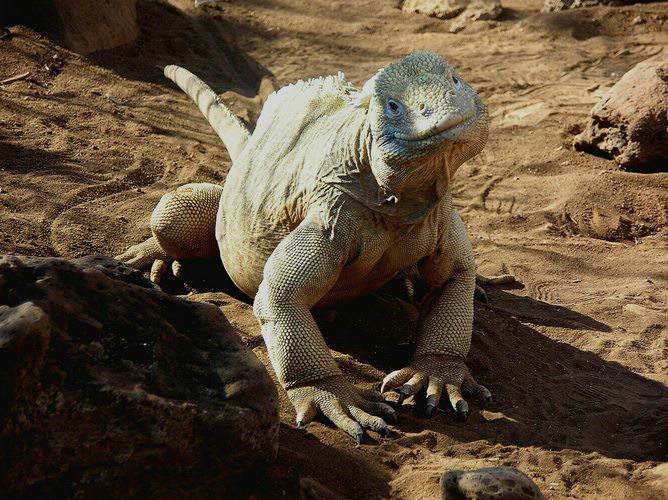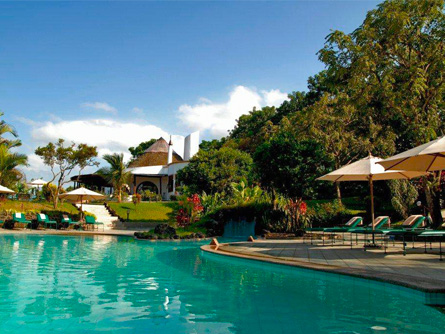
Royal Palm Hotel
Km. 18 Via Puerto Ayora-Baltra Isla, Santa Cruz Island
With animal encounters unlike any other and action-packed excursions galore, a trip to the Galapagos Islands is a vacation you’ll be talking about long after you return home. The islands are a UNESCO World Heritage Center and famous for its one-of-a-kind animals that inspired Charles Darwin’s theory of natural selection.
Explore the protected lands and waters of Galapagos with an experienced naturalist guide during a cruise or land-based tour. Meet swimming iguanas, 500-pound tortoises, social sea lions, and maybe even the amply named flightless cormorant with wings so small it can no longer fly. Biodiversity, beautiful landscapes and natural history collide in the Galapagos and make this remote archipelago off the coast of Ecuador a very magical destination.
The Galapagos has a subtropical climate. Despite its equatorial position, the archipelago is at the confluence of cold ocean currents which moderates the tropical heat and keeps temperatures in the mid-70s to mid-80s. Weather changes are graduation between the warm and cool seasons.
Warm Wet Season
Air and ocean temperatures are warmest in the Galapagos during these months. Conditions may be cloudy with occasional showers that often pass quickly.
Cool Drier Season
The dry season in the Galapagos means more blue skies with occasional midday precipitation. The chilly Humboldt Current passes through the islands during these months, cooling the air and ocean temperatures. The current also brings with it a mist-like drizzle, called garúa in Spanish, which coats island volcanoes and keeps the highlands in the Galapagos lush and green.
The best time to visit the Galapagos boils down to why you want to visit, how you want to explore, and your preferences about the weather.
Galapagos National Park was established in 1959 to protect the special animal and plant species living in the archipelago and manage permanent conservation efforts. It encompasses 97 percent of all land area of the islands and 100 percent of the surrounding marine habitat.
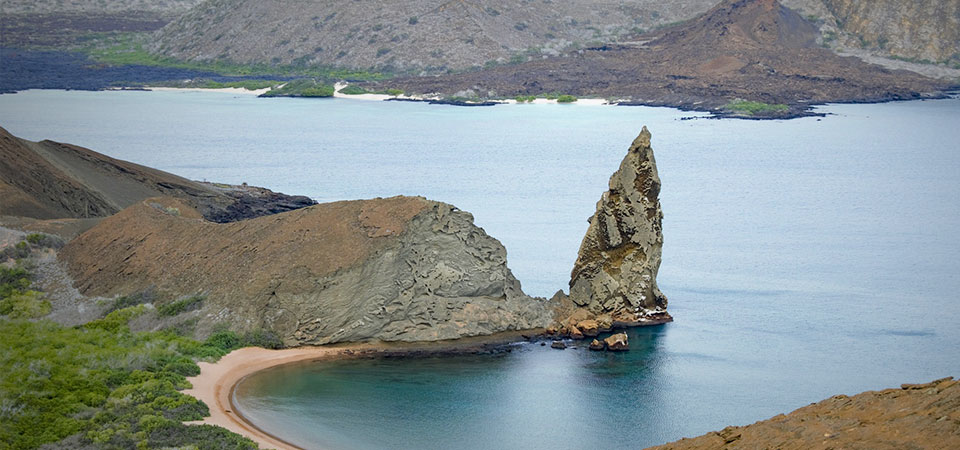
Only four islands are permanently inhabited by humans. The rest of the islands can only be visited at designated terrestrial and marine sites with a guide.
Santa Cruz is home to the archipelago’s largest human population (~12,000), but still, the majority of the land is protected for resident marine iguanas, eight different species of finches, and other animals. Many travelers spend (at least a little) time on Santa Cruz when they come to the Galapagos. It’s only a 5-minute ferry ride to cross the Itabaca Channel from Seymour Airport on Baltra Island to Santa Cruz. From here, you can board your cruise or drive across the island and check-in at an accommodation in the town of Puerto Ayora.
The selection of restaurants, hotels with wifi, and souvenir shops lining Avenida Charles Darwin in Puerto Ayora brings the Galapagos into the 21st century and makes it a comfortable spot for island exploration. Learn about conservation projects at the Charles Darwin Research Station, take an independent nature walk to Turtle Bay, enjoy a morning dip at Las Grietas, and relax at Garrapatero Beach.
The town of Puerto Baquerizo Moreno on San Cristobal is being developed as the main hub for tourism, second to Santa Cruz. Puerto Baquerizo is easily navigated on foot, hosts several options for dining, and the airport is conveniently just outside of town.
Popular attractions on San Cristobal include the Interpretation Center, spotting frigatebirds along the hike to Cerro Las Tijeretas, and a volcanic crater lake named Lagoon el Junco. San Cristobal is also a top spot for surfing in the Galapagos.
Isabela is the largest island in the Galapagos and covers 1,790 square miles (4,640 square kilometers). Puerto Villamil on the island’s southern shore hosts a handful of hotels, tour offices, and restaurants, but the sleepy town is much smaller compared to Puerto Ayora and Puerto Baquerizo Moreno.
There are many reasons to extend your stay on Isabela Island. Take a boat tour to a lava arch known as Los Tuneles; walk through the expansive lava field called Tintoreras where you’ll find colonies of baby iguanas and Galapagos hawks; and check out Centro de Crianza, a breeding center for giant tortoises.
Floreana is one of the oldest islands in the Galapagos. Endemic giant tortoises roam about the island’s lush highlands and the coast delights with idyllic beaches. Devil’s Crown, a volcanic crater that is almost completely submerged under the ocean, is a magnificent spot for snorkeling.
Floreana is one of the four inhabited islands in the Galapagos, but with a population of fewer than 200 people, accommodations and tourism services are very limited. Visiting the island on a cruise is far more common than staying overnight in the sleepy port town of Puerto Velasco Ibarra.
Rabida has an area of two square miles (five square kilometers) and is recognized as the place to spot at least nine species of Darwin finches. The island’s distinct red sand is from oxidation that occurred during its volcanic formation.
Genovesa is nicknamed “Bird Island” and a paradise for anyone who loves birdwatching. Darwin Bay is the principal attraction and home to swallow-tailed gulls, frigatebirds, puffball-chicks, lava herons, yellow-crowned herons, red-footed boobies, Nazca boobies, and many more species of birds.
Pinta features active volcanoes on its northernmost point. The island is also home to a variety of animals, the most famous of which was Lonesome George, a Galapagos tortoise who was the last known individual species of his kind. Lonesome George spent his final years living a comfortable existence at the Charles Darwin Research Center until he passed away in 2012.
Fernandina is the youngest island in the Galapagos. Lava flow from its active volcano continues to form the island, so vegetation is sparse with only mangroves and endemic cacti, including lava cactus. Punta Espinosa, a thin stretch of land where marine iguanas lounge on black lava rocks, is one of the island’s main natural attractions.
Santa Fe is the oldest island in the Galapagos geologically. Vegetation forms a thick forest of the largest species of Opuntia cactus. Named after a Spanish city, the island is teeming with the island’s endemic Barrington land iguana. Visit Barrington Bay to spot a colony of sea lions or walk along the cliffs of Santa Fe which provide shelter for red-billed tropicbirds, swallow-tailed gulls, and lava lizards.
Santiago amasses 360 square miles (585 square kilometers), including two overlapping volcanoes. The beautiful isle has many natural landmarks. Puerto Egas is a lava shoreline with rock formations that host an assortment of wildlife such as marine iguanas and colorful Sally Lightfoot crabs. On the island’s eastern coast, walk across an expansive flat lava flow at Sullivan Bay.
Each island in the Galapagos is a living museum of evolution, with creatures that have adapted (over thousands of years) to different landscapes, weather conditions, and occasionally to the infiltration of new species. Reptiles rule the archipelago and land and seabirds are abundant. There are very few endemic mammals and no native amphibians.
Here is an introduction to some of the iconic animals in the Galapagos:
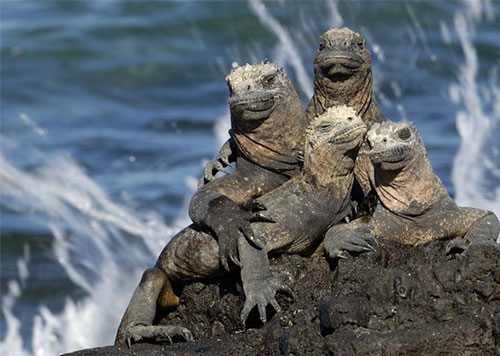
Marine iguanas are the only sea-going lizards in the world. These seaweed-eating reptiles can be spotted along the shores of many islands in the Galapagos.
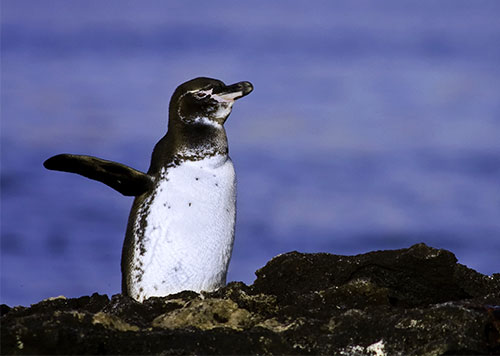
Galapagos penguins are the only penguin species to live north of the equator. They are spotted on Fernandina and the west coast of Isabela.
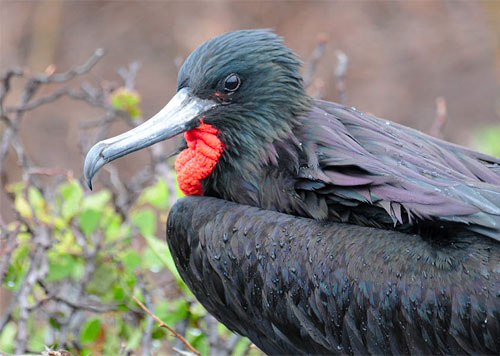
The frigatebird is a large seabird and an endemic subspecies in the islands. Males swell their bright red throat pouch, or gular, to attract a mate.
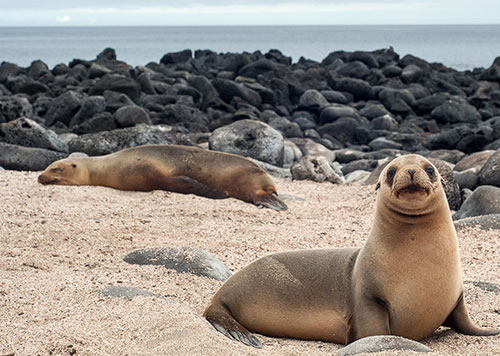
Galapagos sea lions are the most famous endemic marine mammal in the Galapagos. They are related to the California sea lion, but smaller, and love to swim alongside snorkelers.
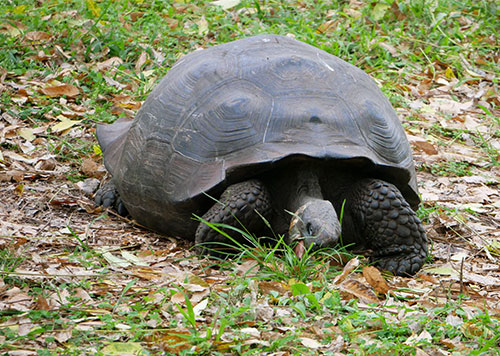
Galapagos giant tortoises can grow to be 500 lbs (230 kg) and live to be 100 years old. Giant tortoises are found on several islands but exist in larger numbers on Isabela Island.
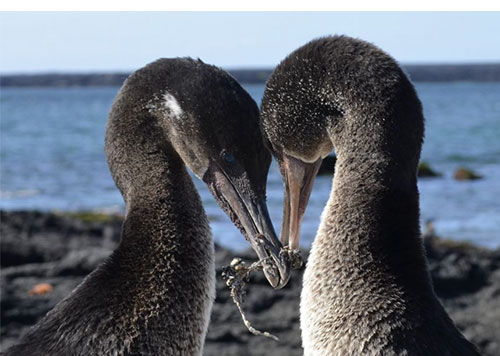
The flightless cormorant may have wings too small to fly but they are agile swimmers. This rare species of bird is endemic to Galapagos and can be spotted on Isabela and Fernandina.
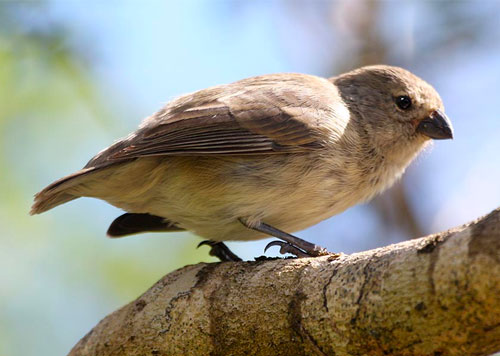
Galapagos finches are widely known as Darwin finches. There are thirteen separate species of this bird residing all over the archipelago.
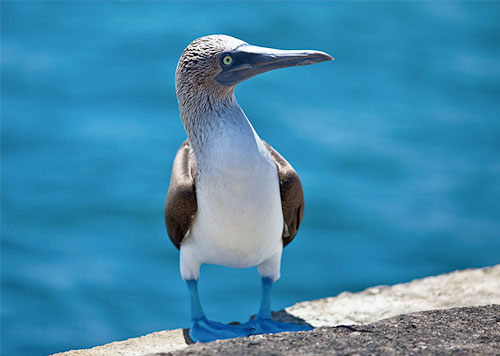
Blue-footed boobies come to the Galapagos Islands to nest along the rocky coasts. These birds are very popular with visitors for their large blue feet and an entertaining dance they perform during the mating season between June and August.
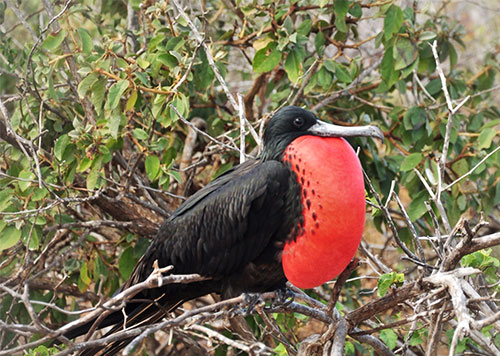
Great frigatebirds are large seabirds and males are known for swelling their bright red gular (throat) sac to attract a female during mating season.
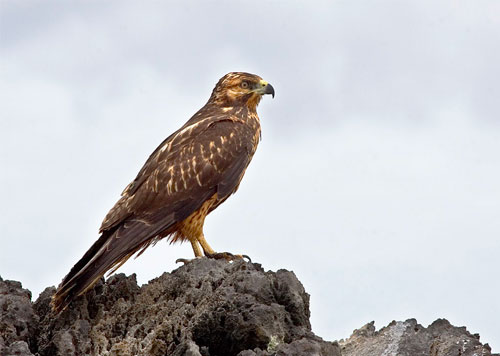
Galapagos hawks are one of the only endemic predators to the archipelago and feed on insects, baby lizards, and other small animals. They are spotted frequently on larger islands, including Isabela and Santa Cruz.
The discovery of the Galapagos archipelago came in 1535 when Dominican Fray Tomás de Berlanga, the Bishop of Panama, was on his way to Peru to mediate an argument between a Spanish conquistador and his lieutenants after their conquest of the Incas. His ship drifted to the islands when the winds died. Since then, the Galapagos Islands have been a source of various social, economic, and scientific interests over the decades.
Pirates once used the islands as a hiding place for gold and silver treasures they pilfered from the Spanish. The location of the Galapagos also made it a convenient place to repair their ships and refuel food - principally tortoise meat - for long sea voyages.
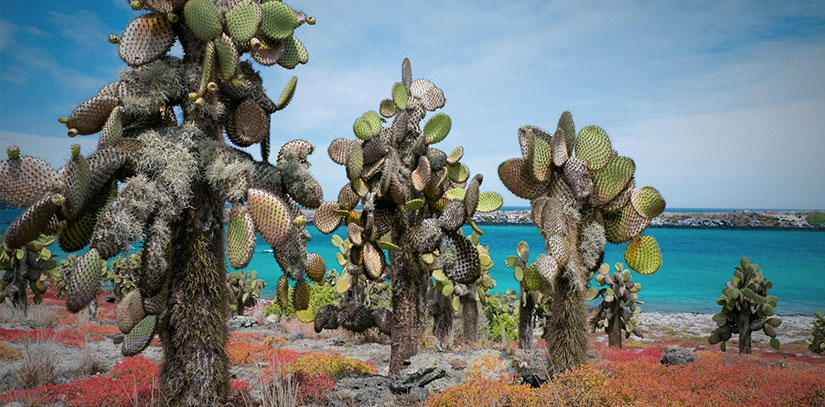
The Galapagos Islands became part of Ecuador in 1833 and a few years later Charles Darwin visited the Galapagos Islands for the first time during a scientific survey expedition aboard the HMS Beagle. Darwin was amazed not only by how creatures in the Galapagos were so different from their mainland counterparts but also by the fact that even between the islands, species with similar characteristics still managed to adapt uniquely and perfectly to their environment. Darwin famously wrote about his theory of evolution in On the Origin of Species based on his observations in the Galapagos Islands.
Charles Darwin forever changed science with evolutionary biology and the trajectory for how the world has come to know this remote archipelago off the coast of Ecuador. Today, the Galapagos Islands capture the hearts of the scientific community and globetrotters alike. The islands are a UNESCO World Heritage Center where conservation intertwines with the local tourism.
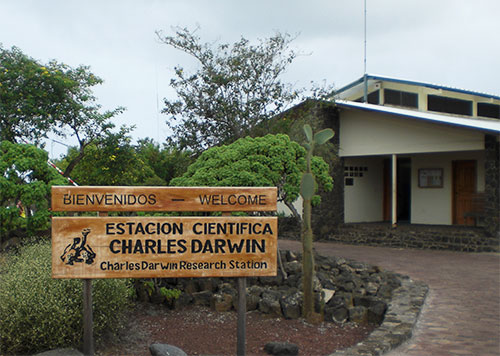
Enhance your Galapagos experience with an educational visit to Charles Darwin Research Station in Puerto Ayora. Spend a few hours learning about crucial conservation efforts underway in the Galapagos, visit the animals, and expand your knowledge of the history of the archipelago. Alternatively, the San Cristobal Interpretation Center is a good natural history museum in Puerto Baquerizo Moreno.
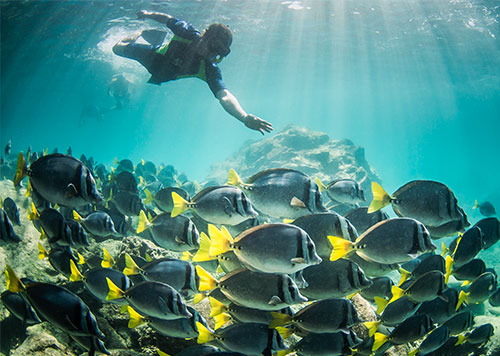
Jump in the water with your snorkeling gear and swim amid large schools of fish, sea turtles, friendly sea lions, and stingrays resting on the sandy floor. Each island has a variety of coral reefs, lagoons, and mangroves to explore. Among the best snorkeling spots in the Galapagos are Kicker Rock off San Cristobal Island; a shallow water channel called Chinese Hat Isle (Sombrero Chino) accessible from Santiago Island, and North Seymour Island.
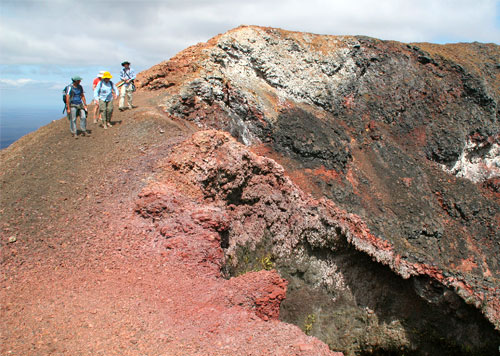
Sierra Negra (or Cerro Negro, which means Black Mountain) is one of five volcanoes on Isabela Island and reminds visitors of the geological formation of the islands. Shake up your wildlife excursions in the Galapagos with a guided hike to the crater summit of Sierra Negra. Expanding six miles (10 kilometers) wide at its rim, the volcano boasts the second largest caldera in the world.
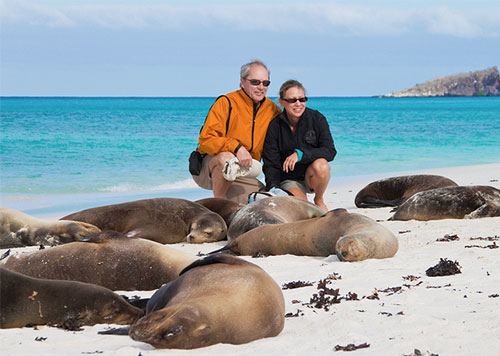
Wildlife is the main attraction of the Galapagos, but this remote archipelago is not without its fair share of white sand beaches with turquoise waters. Your beach towel is the perfect spot to enjoy some vacation downtime after a refreshing ocean swim or snorkel. A visit to Tortuga Bay (also known as Bahía Tortuga) is a nice way to spend a free afternoon in Puerto Ayora. From town, take a 2-mile (3.2-km) stroll along a nature trail until you reach the beautiful Galapagos Beach at Tortuga Bay.
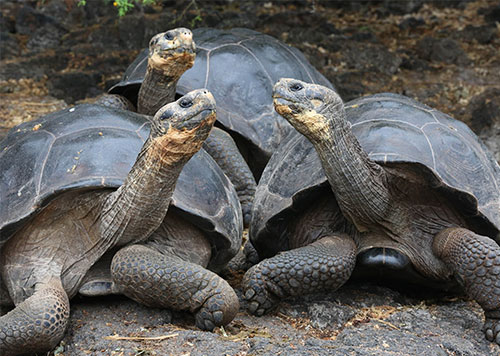
Giant tortoises are probably the most iconic residents of the Galapagos. The next best thing to observing these slow-moving giants at random is the wild is visiting one of the animal reserves dedicated to protecting them. El Chato Giant Tortoise Reserve is in the lush highlands of Santa Cruz Island and visitors are invited to walk around for up-close encounters. Other great options are La Galapaguera on San Cristobal and the Tortoise Breeding Center on Isabela.
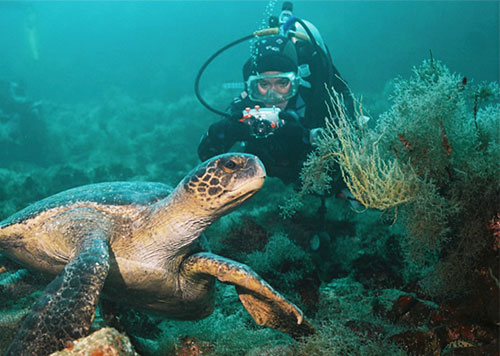
The Galapagos Islands are one of the world’s best destinations for scuba divers to observe large marine wildlife. All of the ocean habitats are protected and home to sea lions, turtles, enormous schools of fish, Galapagos sharks, whitetip reef sharks, hammerheads, manta rays, and even migrating whale sharks. Ask your travel advisor about planning a land-based package with daily diving excursions or the possibility of adding scuba diving to your cruise. Please note that strong currents and choppy conditions during entry are among the reasons why Galapagos diving is for advanced divers and not recommended for newbies.
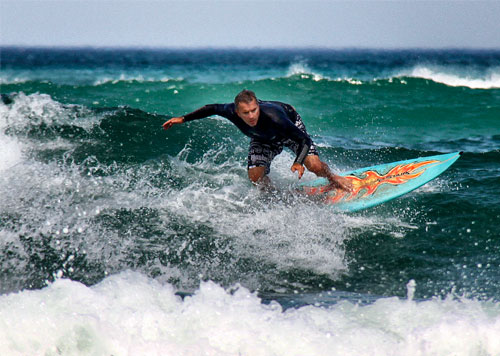
There are good breaks throughout the Galapagos but park restrictions make them inaccessible to surfers. Most of the known waves in the Galapagos are near port towns where surfers can access surf spots themselves. San Cristobal is the best island for surfing in the Galapagos because its western coast gets hit by both north and south swells. La Loberia and Tongo Reef are some of the most popular spots to paddle out near Puerto Baquerizo Moreno.
Take an all-inclusive cruise to remote islands in the national park. Or, base your stay on land in a port town on Santa Cruz, San Cristobal, or Isabela and mix daily excursions with free time. What’s the right choice for you?
Galapagos Cruise
Cruises are convenient and fun. An activity-packed itinerary is already planned and all you have to do is show up to experience it. Vessels often travel between islands at night, so you wake up at a new destination which increases your chances of seeing more diversified wildlife. Many terrestrial and marine sites in the Galapagos are very isolated and can only be accessed on a boat. Routes through the archipelago explore different regions of the national park and itineraries range from 4 days to 8 days and more. Some cruises have kayaks and snorkeling gear for passengers and others cater scuba divers. If you are prone to motion sickness, go with a larger, more stable boat like the Galapagos Legend to avoid seasickness. Smaller yachts and sailboats are the least stable in the water.
Land Tour
Land-based exploration offers more trip flexibility and is likely the way to go if you get seasick. After daily wildlife and nature excursions, unwind at your hotel or enjoy independent exploration around town. Go to the beach, dine at a restaurant, or buy keepsake Galapagos shirts at a local store. In general, hotel and lodge accommodations in port towns are more comfortable and spacious than boat cabins. You can also customize your itinerary to include overnights on Santa Cruz, Isabela, and/or San Cristobal.
Read more about cruising versus land tours in the Galapagos.
Taking a cruise through the Galapagos is an all-inclusive way to explore the archipelago. Every day you wake up at a new destination and take guided excursions that enhance your understanding of the natural and geological wonders of these islands.
Galapagos cruises include daily meals and qualified naturalist guides to accompany you on your journey to different sites within Galapagos National Park, and our preferred cruises offer a range of onboard amenities as well as itinerary length. From mid-size cruise ships that give you more room to stretch your legs on deck to luxury catamarans and sailboats with a more intimate setting, there are a lot of options.
Accommodations in the Galapagos are most diverse in Puerto Ayora, Santa Cruz Island, which is why many of our preferred hotels are located in this port town. Treat yourself to a luxury resort in one of the most unique destinations in the world or stay in town for convenient access to local restaurants, shops, and attractions within walking distance. Of course, if you prefer, your travel advisor will customize a land-based Galapagos vacation with overnights on San Cristobal Island, Isabela Island, or Floreana Island.

Km. 18 Via Puerto Ayora-Baltra Isla, Santa Cruz Island
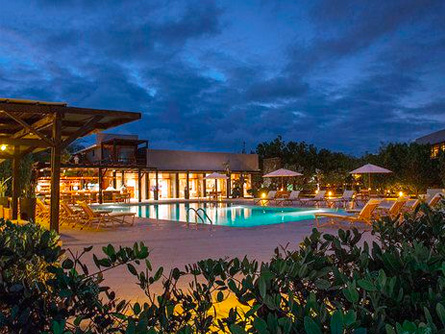
A short boat taxi from the docks in Puerto Ayora, Santa Cruz Island
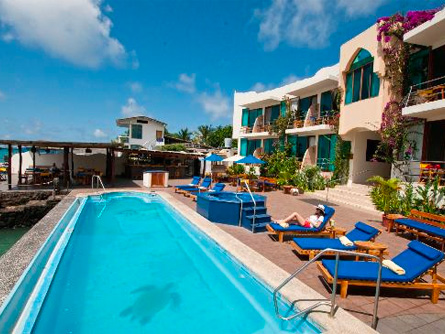
Avenida Charles Darwin & Thomas de Berlanga, Puerto Ayora, Santa Cruz Island
Start Planning
A good rule of thumb is to book early when planning a trip to the Galapagos. How early? Usually about one year in advance. This is particularly true if you want to visit during high season when some cruises book twelve to eighteen months in advance.
How to Get to the Galapagos
Flying to the Galapagos Islands from mainland Ecuador is by far the most popular option. Even cruise passengers fly to the archipelago before boarding their boat.
The Galapagos has two airports with service to mainland Ecuador:
All flights to the Galapagos depart from mainland Ecuador.
Health
What to Pack
Clothing essentials:
Wildlife spotting essentials:
Additional accessories to comfortably explore the Galapagos:
Entering the Galapagos National Park
You need to pay a mandatory park fee that helps cover the management expenses of its land and marine habitats. Payment is made in US cash at Baltra Airport or Seymour Airport.
Galapagos National Park Fees:
Getting Around the Galapagos
Galapagos National Park Rules
The golden rules of the national park are paraphrased below:
Local Currency
The US dollar is the official currency in the Galapagos, as it is for all of Ecuador. Cash is king in the Galapagos. In addition to the national park fee ($100 per adult), cash is also convenient to have - ideally in small notes – to pay for meals, make small store purchases, and tip your guide(s). There are ATMs in Puerto Ayora and Puerto Baquerizo Moreno.
The Galapagos Islands are located about 600 miles (965 kilometers) off the coast of mainland Ecuador in South America. View a Galapagos Islands Map in the Overview section.
The Galapagos Islands are famous for inspiring Charles Darwin’s theory of evolution by natural selection. The one-of-a-kind animal species that call this remote archipelago home and their total lack of concern over humans approaching them have captured the wonderment of scientists and nature enthusiasts for decades.
Yes, people live in the Galapagos full-time but the movement to and from the remote archipelago is regulated by the government of Ecuador and even most Ecuadorian citizens cannot simply pick up and move there from the mainland. In total, around 25,000 people live in the Galapagos. Only three percent of all land in the islands is dedicated to human settlements and the other ninety-seven percent is protected by Galapagos National Park.
A trip to the Galapagos is more expensive than other island destinations, but travelers with their heart set on exploring this remote archipelago are often willing to make the vacation splurge to experience one of the most unique destinations in the world. All visitors pay the mandatory entry fee to Galapagos National Park ($100) and roundtrip airfare to and from mainland Ecuador ($400 and up for non-Ecuadorian citizens) is rarely discounted.
Cruises tend to be more expensive than land-based packages but remember that cruise packages include daily meals, excursions, onboard activities, and sometimes even flights to/from mainland Ecuador. Browse a variety of Galapagos cruises from more moderately priced mid-sized ships to high-end catamarans.
Land-based exploration of the Galapagos is considered more budget-friendly because you have more itinerary options and wiggle room to adjust expenses to fit within your desired budget. Go all out and stay at a luxury lodge or select a more modestly priced hotel. Also, mix guided excursions included in your itinerary with leisure time on the islands (there are a lot of free outdoor activity options) and save money on where you dine out.
If you prefer not to take a cruise, then you can stay at a hotel in one of the towns of an inhabited island. Puerto Ayora and Puerto Baquerizo Moreno are the busiest towns in the Galapagos with hotels, restaurants, and souvenir shops that cater to tourists as well as grocery stores, schools, and municipality buildings for locals. For a more quiet island stay consider Puerto Villamil on Isabela Island.
The Galapagos Islands are part of Ecuador. Most visitors, including citizens of the United States and Canada, are allowed to stay in Ecuador on a tourist visa for up to 90 days, renewable for an additional 90 days. Check on South America visa requirements with your Travel Advisor. All travelers to Ecuador are required to have a passport valid for at least 6 months, and you should carry a copy of your passport with you at all times.
You need close to two weeks to visit Machu Picchu in Peru and Galapagos in Ecuador. Make the best of your time in these two remarkable destinations in South America by starting your adventure in Peru. Upon arrival, immerse yourself in the enchanting Andean traditions of Cusco and then marvel at the Inca-built Machu Picchu, one of the New Seven Wonders of the World. Once you've taken in Cusco and Machu Picchu, journey north to the Galapagos Islands to wrap up the trip of a lifetime in the company of the world’s more rare animals. Check out our 11-day Inspiring Incas & Great Galapagos package and customize it with your travel advisor.
The tourist card (sometimes called INGALA) is an immigration control measure that enables the government of Ecuador to control immigration to the Galapagos. At the INGALA window in the domestic terminal at the Quito or Guayaquil airports, anyone going to the Galapagos needs to pass their luggage through the special control checkpoint to ensure no animals, seeds, or biohazardous material ends up in the Galapagos.
The tourist card costs $10 each way ($20 roundtrip) per traveler. Keep your card in a safe place with your passport because you’ll need both to get on the plane to the Galapagos and then again at the end of your trip. Ask your travel advisor if the tourist card fee is included in your tour package or not.
Several Galapagos hotels and even some restaurants in the towns of Puerto Ayora, Puerto Baquerizo Moreno, and Puerto Villamil have wifi but the connection is not always good. Internet access is sometimes available on a cruise ship but at an extra charge.
Reasonably good physical condition is required to enjoy a vacation to the Galapagos. Some trails can be challenging in hot and sunny conditions. In some cases, elderly or disabled passengers may find certain activities and uphill trails beyond their comfort level. Notify your travel advisor of any special circumstances well ahead of time so that necessary arrangements can be made.
Maximize your enjoyment of the remote Galapagos archipelago off Ecuador’s coast.
Enjoy a trip to the Galapagos without any regrets! Use this helpful packing list to make sure you travel with all the essentials.

